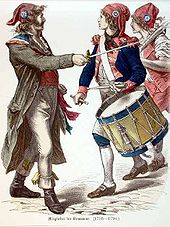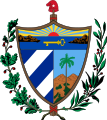Phrygian cap
A Phrygian cap [ ˈfryːgɪʃə ], more rarely also called Scythian cap [ ˈskyːtɪʃə ], was originally worn by the ancient Phrygians . It was made of wool or leather and had a longer, round tip that was usually knocked forward or fell towards the forehead. It could also be tied under the chin with straps that fell on the side. The part of the neck sometimes covered the temples and sometimes reached down to the shoulders.
The Phrygian cap was originally a tanned bull scrotum with the surrounding fur. According to the idea of the Greeks, such a piece of clothing should transfer the special abilities of the animal to its wearer.
Similar pointed hats are known today from garden gnomes , Santa Claus - both in red - and cartoon characters like the Smurfs or the Mainzel males .
Antiquity
The Phrygian cap was originally worn by the Phrygians and other Indo-European Anatolian peoples. Apparently it developed parallel to the Phrygian helmet from the "Homeric leather helmet". Already in the Homeric epics a cap-like headgear called kataityx is mentioned, which was probably made from the same part of the bull's fur, around the scrotum, as the helmet, but was not dried hard, but tanned soft . Later it became characteristic of the Iranians and Thracians as a tiara .
The Persian god Mitra is always depicted with a Phrygian cap, as is Mithras , who may be equated with him and revered in the Roman Empire , and the Phrygian Attis . Other oriental deities that are often represented with her are the fertility god Sabazios , the Phrygian moon deity Men and Iupiter Dolichenus, which is particularly popular with Roman soldiers . Other mythological figures who often wear a Phrygian cap are: Orpheus , Adonis , Ganymede and Paris . The only female deity with a Phrygian cap is Bendis , the Thracian goddess of the hunt , usually equated with Diana .
Occasionally they are even worn by Odysseus returning from a foreign country, but mostly the round pilos of the sailors. Women who wear the hat are almost always amazons .
The ancient Greeks considered the Phrygian cap, just like trousers, to be typically barbaric clothing, and whenever the Greeks depicted Persians , Scythians or members of other peoples they considered barbarians on vases , wall paintings or mosaics , they depicted them with a Phrygian cap. Forms made of felt, fur or leather with long ear and neck tabs that could be wrapped around the chin and neck like a scarf predominated, especially with the Scythians, Saks and other ancient steppe nomads. These forms are known in the Eurasian steppes and in the Caucasus under the name Baschlik . The bag could be plump (stuffed) and erect or lie flat like a tongue. The top was preferred to hit forward, but not always. Sometimes (especially with Persian satraps , but also with Amazons) the hat was wrapped with a headband or headband . Occasionally, apparently stiffer shapes, more similar to the tiara or the “Homeric leather helmet”, have a cock-comb-like decoration. Later, simpler forms without tabs that left the ears uncovered became more common in the depictions. The natural color of the tanned leather was brown, but on several vase pictures and wall paintings you can see hats colored in reddish tones. Sometimes the hats are decorated with dots, spirals or flower patterns. The material of the hats (leather, felt, fabric) can usually not be identified in the pictures, nor is the nature of the decorations (painted, embroidered, baked).
The Macedonians ( regarded by the Athenians as barbarians) adopted the Phrygian cap and the similarly shaped Phrygian helmet from the Thracians.
During the French Revolution, the Phrygian cap was confused with the pileus and became a symbol of freedom. The pileus, a felt cap worn on the head, probably originally came from Asia Minor, but later appeared in both Greek and Roman cultures. Well-known figures in Greek mythology who carried the pileus were Odysseus, Hephaestus , Charon and the Dioscuri among the gods . In ancient times, the pileus was mainly worn by sailors, fishermen and craftsmen. It was best known because freed slaves in ancient Rome were allowed to wear this headgear after their release ( freedom hat ).
The so-called Holy Three Kings (biblical magicians from the Orient) were also shown in early images with the Phrygian cap (with headband and neck tab, but without ear tabs), an indication that they may have come from Persia . The Church of the Nativity in Bethlehem is said not to have been destroyed after it was conquered by the Persians in 615 only because they recognized their compatriots on the mosaics there.
Scythian archer on a black-figure, Attic kylix , approx. 530 to 520 BC C. The neck tab of his hat is tucked up behind the headband.
Dareios III. and the Persian warriors surrounding him wear Phrygian caps with long side flaps, the soft pouch of which falls partly forwards and partly backwards, and stands erect by the king. Alexander mosaic , Pompeii , 2nd century BC C.
An Amazon is defeated by a Greek warrior by grabbing her cap, mosaic, Daphne (Antioch) , second half of the 4th century.
The wise men from the Orient with Phrygian hats, mosaic in Sant'Apollinare Nuovo , Ravenna , 6th century
Bust of a Daker with a Phrygian cap from the early 2nd century
Roman statue of Paris with a Phrygian cap, 2nd century
meaning
In ancient times, as with many primitive peoples today , the belief was widespread that the characteristics of animals were passed on to humans when they clad themselves in their skins. For this reason, z. B. Heracles the skin of a lion. The bull was also considered to be the embodiment of particular strength, especially the power of procreation, and played an important role in the cults of the Near East.
In the cult of Mithras, the Phrygian cap was not only the headgear of the revered God himself, but also the highest in the cult secrets initiated mystics . Only they were allowed to understand the primordial bull sacrifice of God, which symbolized the renewal of life, the rebirth of the believer. Women were not allowed to participate in this cult, which was particularly widespread among Roman soldiers. The "legionnaire god" Jupiter Dolichenus was also often depicted in the pose of an emperor, standing on the back of a bull.
In the few female figures who were depicted with Phrygian caps, the headgear with the bull's bag is also an expression of a power that was perceived as particularly “masculine”. As a goddess, Bendis also has her own power of procreation (similar to how the "many-breasted" Artemis is perhaps dressed in a garment made from the testicles of the bulls sacrificed to her). The Amazons are independent of men and equal to them in war.
middle Ages
In Anglo-Saxon writings of the 10th and 11th centuries there are images that appear to depict warriors with Phrygian caps or helmets. However, there is no further evidence of their actual use in early medieval Western Europe. Instead, it seems possible that the images are misunderstood copies or antiquated recourse to Byzantine and Roman sources. In the Middle Ages, however, it can still be found occasionally when depicting people from the Old Testament , such as the prophets . It also found its way into the Corno Ducale , the headgear of the Doges of Venice and became part of the costume of the Neapolitan sailors.
Modern times


The Canadian tuque
The French trappers often used an asymmetrical red-colored headgear, which may have been inspired by the Phrygian hat. In the 19th century it even became a symbol for the French-speaking minority in Canada.
Jacobin hat

During the French Revolution , the Phrygian cap ( French bonnet rouge ) was worn by the Jacobins as an expression of their political commitment. They erroneously believed that the Phrygian cap was worn by freed slaves in antiquity - in fact, they wore a pileus . Therefore, as a so-called freedom cap, it became a symbol of democratic and republican sentiments in the political iconography of France and all of Europe , but also a sign of the Jacobin reign of terror among the opponents of the revolution . The French symbol figure Marianne is also often depicted with a Jacobin cap. Republican depictions of the German Michel from the revolution of 1848/49 often show him wearing a sleeping cap , which was also intended as a parody of the Jacobin cap : unlike his French neighbor, the German Michel “overslept” the possibility of a bourgeois revolution in his own country.
Use as a symbol of freedom and independence
The triumphant advance of the Jacobin hat as a symbol of freedom is also evident in its use in many coats of arms of American states, many of which received their independence in the wake of the French Revolution and the time of Napoleon .
It appears as an important symbol in the coats of arms of Argentina , Bolivia , Colombia , Cuba , Nicaragua and in the coat of arms of the US state of West Virginia . The Phrygian cap is also depicted in the flags of El Salvador , Haiti , Nicaragua and on the back of the flag of Paraguay . It is part of the flags of the US states of New York and New Jersey and the flag of the Brazilian state of Santa Catarina . In addition, the Phrygian cap was used in the former coat of arms of the Dominican Republic (1844-1865) and in the former flag of Argentina (1836 to about 1849). It still appears in the coats of arms and flags of several Argentine provinces: on the flags of Corrientes , Jujuys , Mendozas , San Juans and the coats of arms of Buenos Aires , Catamarcas , Corrientes , Tucumáns , Jujuys and Mendozas .
Seal of the US Senate
Use of the term in medicine
In medicine, the term Phrygian cap is used for a congenital shape variant of the gallbladder , which shows a kinked shape in the X-ray contrast or ultrasound examination . In the differential diagnosis , it must be distinguished from septation of the gallbladder.
See also
- Catalan barretina
- Southwest
- Jacobin cap (heraldry)
literature
- Gérard Seiterle : The original form of the Phrygian cap. In: Ancient World. Journal for Archeology and Cultural History , 16/3, 1985, pp. 2–13.
- Josef Eberle : The red cap. To the story of a symbol of freedom. In: Josef Eberle: Latin nights. Deutsche Verlags-Anstalt, Stuttgart 1967, ISBN 3-421-01331-4 , pp. 281-285.
- Manfred Escherig: Michel's hats and freedom. Excess mythological considerations on some of the emblems of the revolution. In: Michael Knieriem (Ed.): Michels Awakening - Emancipation through uprising? Wuppertal 1998, ISBN 3-87707-526-6 , pp. 294-325.
Individual evidence
- ↑ Gérard Seiterle: The original form of the Phrygian cap . In: Antike Welt 16/3, 1985, pp. 10-11.
- ^ Regia Anglorum.org: Arms and Armor - Part 7 - Helmets.
- ^ Mark Harrison: Anglo-Saxon Thegn AD 449-1066. Osprex, Oxford 2001, ISBN 1-84176-279-2 .

















